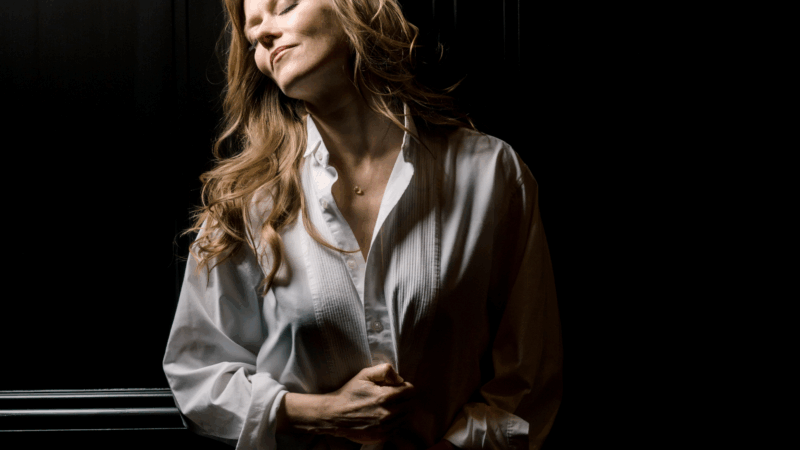Under the spell of Hildegard: A new album reboots ancient music
Barbara Hannigan is fearless in the face of new music. The Canadian soprano has sung the world premiere of over 100 new works, and last year released a recording of songs by the contemporary American composer John Zorn that even she claimed (at first) were unsingable. So it is something of a surprise that Hannigan’s new album is inspired by very old music.
Along with her musical partners — veteran pianists Katia and Marielle Labèque and electronics wiz and composer David Chalmin — Hannigan has fallen under the spell of the 12th century German abbess Hildegard von Bingen. The result, Electric Fields, is an album that unfolds like a fever dream, as if you’ve fallen asleep in a time machine.
Hildegard was a visionary poet, scientist, diplomat and composer. Her music, which continues to attract followers, is over 900 years old, but Hannigan and company view it through a singular 21st-century lens. You can hear the approach as soon as the album opens. “O virga mediatrix” (O branch and mediator) is a mesmerizing, melismatic curtain raiser, with Hannigan’s voice drenched in reverb, backed by a synthetic organ and subtle, droning electronics thanks to Chalmin’s evocative arrangement.
Hildegard may share the album with other women composers of long ago, but she looms large — even over the newly composed pieces. There are two fresh works by The National‘s Bryce Dessner in which the Labèque sisters supply lovely thickets of rippling, almost minimalist sound. But Dessner’s text for “O orzchis Ecclesia” (O measureless Church) and “O nobilissima viriditas” (O most noble greenness) is crafted from the secret language Hildegard invented for her fellow nuns.
These musicians dare to tinker with classics, unearth rare music and pull it all apart. In the song “Che t’ho fatt’io,” by 17th century composer Francesca Caccini (the first woman known to have composed an opera), Hannigan and Chalmin shuffle melodic fragments from the original tune with club beats and spiky electronic blips. It’s a dizzying haze of Baroque elegance dressed in trippy effects.

I admire Hannigan and company, working outside their comfort zones, improvising with live electronics, even in concert. Electric Fields took 10 years to realize, and even now the musicians say they’re not exactly sure what they’ve created.
Two versions of a song by Barbara Strozzi, another neglected 17th century composer, demonstrate the old-new divide on Electric Fields. One rendition of “Che si può fare” (What can be done) is presented fairly straightforwardly, although it devolves into a storm for two pianos and gurgling synths. The other version is an improvisation, nearly unrecognizable as the song amid its flurry of overdubbed voices and tolling pianos, culminating in a chaotic nightmare of electronic effects. At eight minutes long, it can sound noodling at times. Still, it effectively contributes to the larger dreamscape.
The album is both ethereal and sensual thanks to the creative arrangements and the miracle that is Hannigan’s voice. Even when obscured by audio treatments and intellectual concepts, it’s still recognizable for its signature beauty — a pure, bright, gleaming instrument, offering emotional intensity with refined phrasing and long-breathed lines.
In its incantatory final track, the album returns to Hildegard in a slowly-paced, hypnotic arrangement of “O vis aeternitatis” (O force of eternity). When they talk about seeing that great white light somewhere between life and death, this performance would make a fitting soundtrack for that unknowable journey. It ends, literally, on a high note. A 19-second-long, luscious and soaring high C, the likes of which only Hannigan can deliver.
Electric Fields is an experiment that could have gone terribly wrong. But it turned out to be a lucky meeting of disparate musicians who sparked a little dreamy magic while connecting the old with the new.
Trump will drop push for National Guard deployments in Chicago, LA and Portland, Ore.
Courts blocked troops from deploying in Chicago and Portland, Ore., and the Los Angeles deployment effectively ended after a judge blocked it earlier this month.
What Stranger Things gets right about wormholes
The final episode of fifth season of the Netflix series Stranger Things is out this week, and the concept of a wormhole figures largely into it. While the show is a work of fiction, theoretical wormholes have making appearances for decades not only in science fiction but in actual science.
Photos: The world welcomes the new year
As fireworks light the sky and crowds count down together, communities around the globe welcome 2026.
Meet five new species discovered in 2025
A bumpy snailfish, Andean mouse opossum and ancient sea cow were just some of the many species described in 2025.
What to know about Nick Shirley, the YouTuber alleging daycare fraud in Minnesota
Shirley is a 23-year-old self-described "independent YouTube journalist" who made prank videos in high school before pivoting to politics. He participated in a White House roundtable in October.
Greetings from Vienna, where an imperial palace hosts a holiday market for all
Far-Flung Postcards is a weekly series in which NPR's international team shares moments from their lives and work around the world.







